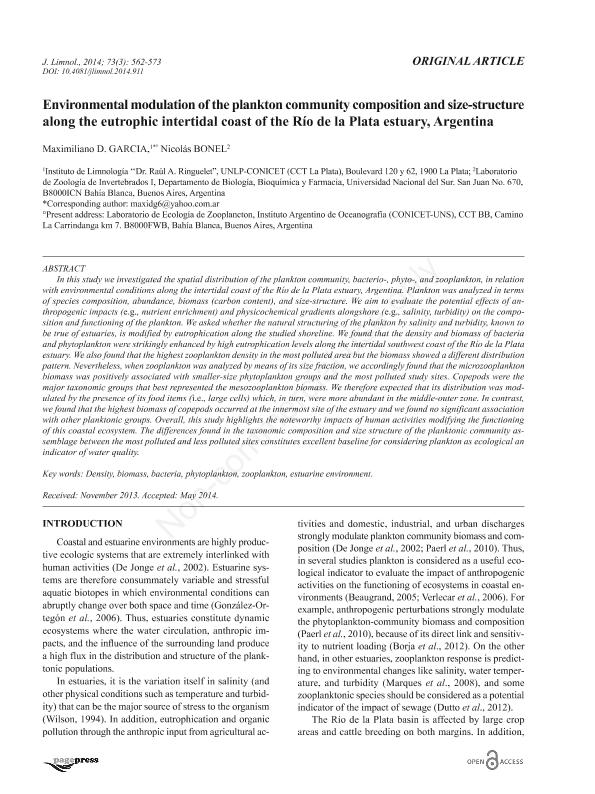Artículo
Environmental modulation of the plankton community composition and size-structure along the eutrophic intertidal coast of the Río de la Plata estuary, Argentina
Fecha de publicación:
05/2014
Editorial:
Page Press
Revista:
Journal of Limnology
ISSN:
1129-5767
e-ISSN:
1723-8633
Idioma:
Inglés
Tipo de recurso:
Artículo publicado
Clasificación temática:
Resumen
In this study we investigated the spatial distribution of the plankton community, bacterio-, phyto-, and zooplankton, in relation with environmental conditions along the intertidal coast of the Río de la Plata estuary, Argentina. Plankton was analyzed in terms of species composition, abundance, biomass (carbon content), and size-structure. We aim to evaluate the potential effects of anthropogenic impacts (e.g., nutrient enrichment) and physicochemical gradients alongshore (e.g., salinity, turbidity) on the composition and functioning of the plankton. We asked whether the natural structuring of the plankton by salinity and turbidity, known to be true of estuaries, is modified by eutrophication along the studied shoreline. We found that the density and biomass of bacteria and phytoplankton were strikingly enhanced by high eutrophication levels along the intertidal southwest coast of the Río de la Plata estuary. We also found that the highest zooplankton density in the most polluted area but the biomass showed a different distribution pattern. Nevertheless, when zooplankton was analyzed by means of its size fraction, we accordingly found that the microzooplankton biomass was positively associated with smaller-size phytoplankton groups and the most polluted study sites. Copepods were the major taxonomic groups that best represented the mesozooplankton biomass. We therefore expected that its distribution was modulated by the presence of its food items (i.e., large cells) which, in turn, were more abundant in the middle-outer zone. In contrast, we found that the highest biomass of copepods occurred at the innermost site of the estuary and we found no significant association with other planktonic groups. Overall, this study highlights the noteworthy impacts of human activities modifying the functioning of this coastal ecosystem. The differences found in the taxonomic composition and size structure of the planktonic community assemblage between the most polluted and less polluted sites constitutes excellent baseline for considering plankton as ecological an indicator of water quality.
Palabras clave:
Bacteria
,
Phytoplankton
,
Zooplankton
,
Estuarine Enviroment
,
Density
,
Biomass
Archivos asociados
Licencia
Identificadores
Colecciones
Articulos(CCT - BAHIA BLANCA)
Articulos de CTRO.CIENTIFICO TECNOL.CONICET - BAHIA BLANCA
Articulos de CTRO.CIENTIFICO TECNOL.CONICET - BAHIA BLANCA
Articulos(IADO)
Articulos de INST.ARG.DE OCEANOGRAFIA (I)
Articulos de INST.ARG.DE OCEANOGRAFIA (I)
Articulos(ILPLA)
Articulos de INST.DE LIMNOLOGIA "DR. RAUL A. RINGUELET"
Articulos de INST.DE LIMNOLOGIA "DR. RAUL A. RINGUELET"
Citación
Garcia, Maximiliano Darío; Bonel, Nicolás; Environmental modulation of the plankton community composition and size-structure along the eutrophic intertidal coast of the Río de la Plata estuary, Argentina; Page Press; Journal of Limnology; 73; 3; 5-2014; 562-573
Compartir
Altmétricas




